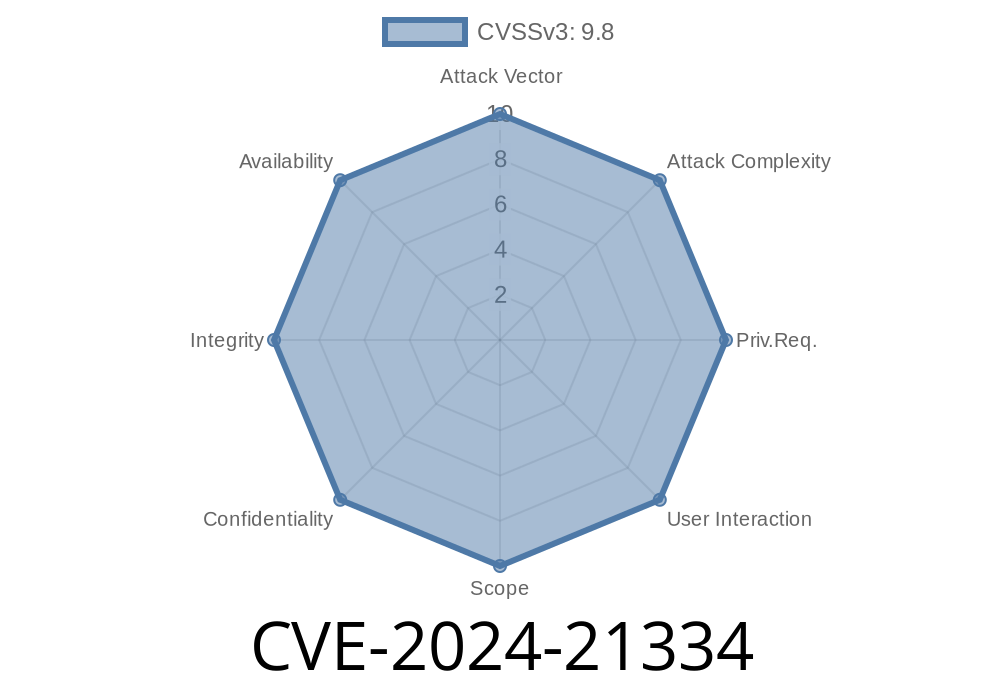Attention all security professionals! A new vulnerability has been identified in the Open Management Infrastructure (OMI) that has a significant impact on many systems. This Remote Code Execution (RCE) vulnerability enables attackers to execute malicious commands on a target system, potentially causing widespread damage. The details of this vulnerability, which has been assigned the CVE identifier CVE-2024-21334, have recently become available. In this post, we will dive deep into the details of this vulnerability, examine code snippets showcasing the issue, explore available exploits, and provide references for further reading.
Vulnerability Description
CVE-2024-21334 affects the Open Management Infrastructure (OMI), a widely used open-source system management project. Many organizations rely on OMI for managing their infrastructure, as it plays a vital role in monitoring and controlling the functioning of servers and resources. This particular RCE vulnerability allows an unauthenticated attacker to execute arbitrary code on an affected system, bypassing regular authentication and authorization measures.
The root cause of this issue is a lack of proper input validation in certain parts of the OMI software. When handling specially crafted packets that contain malicious data, OMI fails to sanitize input adequately, leading to remote code execution possibilities.
Here's an example of the vulnerable code
void parsePacket(packet_t *packet) {
...
size_t dataLength = packet->dataLength;
char data[256];
memcpy(data, packet->data, dataLength); // <- Buffer overflow here!
...
handleData(data);
}
In this snippet, the parsePacket function takes in a packet_t structure and copies the data field into a fixed-size buffer without ensuring it fits the available space. When the memcpy function is called, data of an arbitrary length can be copied, resulting in a buffer overflow. This allows an attacker to exploit the vulnerability and execute arbitrary code in the targeted system.
Original References
For an in-depth analysis of the technical details behind this vulnerability, please refer to the following official resources:
1. Microsoft Security Response Center – Microsoft provides a comprehensive analysis of the vulnerability and offers advice on how to protect against it, including applying patches and updates.
2. GitHub Advisory – The OMI project has published a security advisory with more details about the vulnerability, possible workarounds, and guidance for securing your implementation of the software.
Exploit Details
Given the severity of CVE-2024-21334, it's essential to be aware of the potential exploits that take advantage of this vulnerability. Multiple proof of concepts (PoCs) have been released by security researchers, demonstrating the ease with which an attacker can exploit this issue.
One example is the following Python-based script that sends a malicious packet to an affected OMI system, causing the target to execute arbitrary commands:
#!/usr/bin/env python3
import socket
import sys
TARGET_IP = "10...2"
TARGET_PORT = 5985
COMMAND = "calc.exe"
def exploit(target_ip, target_port, command):
packet = create_malicious_packet(command)
sock = socket.socket(socket.AF_INET, socket.SOCK_STREAM)
sock.connect((target_ip, target_port))
sock.sendall(packet)
sock.close()
def create_malicious_packet(command):
# [Payload creation goes here]
return payload
if __name__ == "__main__":
exploit(TARGET_IP, TARGET_PORT, COMMAND)
Take note that running such an exploit should only be done in testing environments with proper consent.
Conclusion
CVE-2024-21334 is a critical vulnerability affecting the Open Management Infrastructure (OMI), granting attackers the ability to execute arbitrary code on a target system. It is essential for organizations and individuals to be aware of this vulnerability and take the necessary steps to protect their infrastructure. Stay informed by consulting the provided references and consider implementing the recommended patches, updates, and mitigations immediately.
Timeline
Published on: 03/12/2024 17:15:49 UTC
Last modified on: 03/12/2024 17:46:17 UTC
